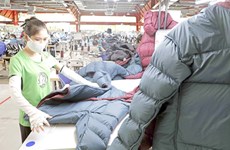Shoe exports stride towards lucrative year
Domestic shoemakers expect to export goods worth 5.4 billion USD by the year-end, industry leaders say.
Domestic shoemakers expect to export goods worth 5.4 billion USD by the year-end, industry leaders say.
Nguyen Duc Thuan, chairman of the Vietnam Leather and Footwear Association (Lefaso), said at a press conference last week that more than 500 leather-shoe makers were confident that the industry's export value would reach record figures this year.
The confidence was based on actual market conditions, Thuan said.
In 2009, the industry exported shoes worth 4.1 billion USD despite several difficulties caused by the global economic recession.
In the first seven months of this year, its export earnings climbed to 2.79 billion USD, up 15.3 percent year on year.
Members still held many high-value export contracts from now to the year-end, he said.
Over the last few years, the industry has grown by 10 and 15 percent per year, and emerged as the country's third largest export earner. It would strive to maintain the momentum this year, Thuan said.
Diep Thanh Kiet, vice chairman of the HCM City Leather and Footwear Association, said Vietnam was the world's fourth biggest exporter of leather footwear, with major overseas markets being the US and Japan. These markets each year consumed about 120 and 125 million made-in-Vietnam footwear, he said.
Industry leaders said some favourable conditions had helped them do well in the international market.
Thuan said the industry had a highly professional and skilled workforce of about 650,000 people.
Countries whose per capita GDP was less than 4,000 USD per year would be able to be remain competitive for some time, he said.
In Vietnam , he said, per capita GDP was predicted to stand at 3,500 USD per year until 2020. This means that the domestic leather-shoe industry still had potential to compete with those in regional countries, he added.
Another favourable condition for the domestic shoe industry to keep its growth is that demand for leather footwear was still very high.
Worldwide, about 17 billion pairs of shoes are produced every year, of which six and seven billion were manufactured under export contracts.
Thuan said that despite the favourable conditions, the domestic leather-shoe industry also faced several obstacles to meeting its development potential.
The industry was heavily reliant on imported materials and accessories. The capital that shoemakers needed to buy materials accounted for up to 60 percent of the total value of a product, he said.
There were just 20 enterprises in the country involved in the leather tanning industry so they would not be able to supply enough processed leather for shoemakers, Thuan explained.
A representative of the Vietnam Leather-Shoe Joint Stock Company (Vina-Giay), also said one of the biggest problems facing the industry was poor tanning capacity and skills.
Meanwhile, shoemakers and suppliers of materials and accessories were yet to establish close co-operation with each other, he said.
Another limiting factor for the industry was that Vietnamese shoemakers were paying inadequate attention to the lucrative domestic lucrative market, said Vu Van Cham, chairman of the HCM City Leather and Footwear Association.
Half of the domestic market was now occupied by foreign shoemakers, which made domestic shoemakers over-reliant on export manufacturing contracts, and they suffered badly when overseas markets fluctuated, Cham said.
Up to 97 percent of the Vietnamese shoemakers are small and medium-sized enterprises who find it difficult to develop hi-tech production infrastructure and implement high-value contracts, he said./.
Nguyen Duc Thuan, chairman of the Vietnam Leather and Footwear Association (Lefaso), said at a press conference last week that more than 500 leather-shoe makers were confident that the industry's export value would reach record figures this year.
The confidence was based on actual market conditions, Thuan said.
In 2009, the industry exported shoes worth 4.1 billion USD despite several difficulties caused by the global economic recession.
In the first seven months of this year, its export earnings climbed to 2.79 billion USD, up 15.3 percent year on year.
Members still held many high-value export contracts from now to the year-end, he said.
Over the last few years, the industry has grown by 10 and 15 percent per year, and emerged as the country's third largest export earner. It would strive to maintain the momentum this year, Thuan said.
Diep Thanh Kiet, vice chairman of the HCM City Leather and Footwear Association, said Vietnam was the world's fourth biggest exporter of leather footwear, with major overseas markets being the US and Japan. These markets each year consumed about 120 and 125 million made-in-Vietnam footwear, he said.
Industry leaders said some favourable conditions had helped them do well in the international market.
Thuan said the industry had a highly professional and skilled workforce of about 650,000 people.
Countries whose per capita GDP was less than 4,000 USD per year would be able to be remain competitive for some time, he said.
In Vietnam , he said, per capita GDP was predicted to stand at 3,500 USD per year until 2020. This means that the domestic leather-shoe industry still had potential to compete with those in regional countries, he added.
Another favourable condition for the domestic shoe industry to keep its growth is that demand for leather footwear was still very high.
Worldwide, about 17 billion pairs of shoes are produced every year, of which six and seven billion were manufactured under export contracts.
Thuan said that despite the favourable conditions, the domestic leather-shoe industry also faced several obstacles to meeting its development potential.
The industry was heavily reliant on imported materials and accessories. The capital that shoemakers needed to buy materials accounted for up to 60 percent of the total value of a product, he said.
There were just 20 enterprises in the country involved in the leather tanning industry so they would not be able to supply enough processed leather for shoemakers, Thuan explained.
A representative of the Vietnam Leather-Shoe Joint Stock Company (Vina-Giay), also said one of the biggest problems facing the industry was poor tanning capacity and skills.
Meanwhile, shoemakers and suppliers of materials and accessories were yet to establish close co-operation with each other, he said.
Another limiting factor for the industry was that Vietnamese shoemakers were paying inadequate attention to the lucrative domestic lucrative market, said Vu Van Cham, chairman of the HCM City Leather and Footwear Association.
Half of the domestic market was now occupied by foreign shoemakers, which made domestic shoemakers over-reliant on export manufacturing contracts, and they suffered badly when overseas markets fluctuated, Cham said.
Up to 97 percent of the Vietnamese shoemakers are small and medium-sized enterprises who find it difficult to develop hi-tech production infrastructure and implement high-value contracts, he said./.












